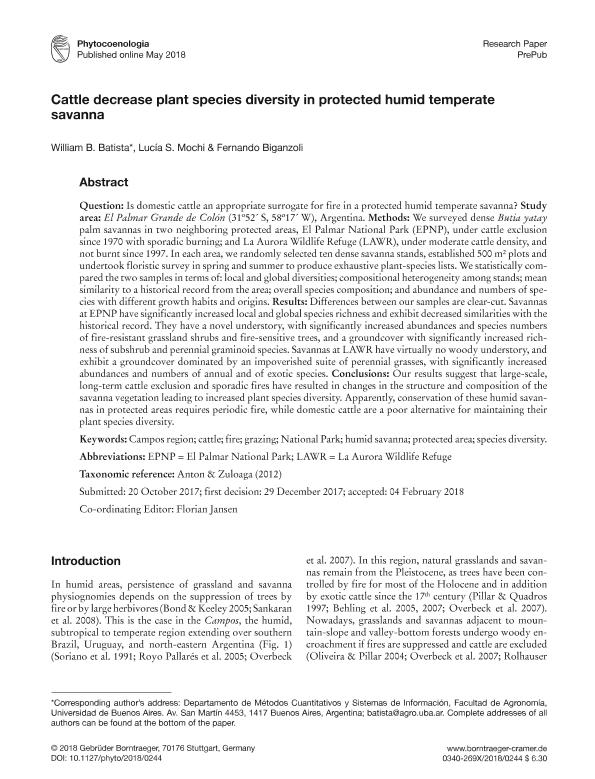Mostrar el registro sencillo del ítem
dc.contributor.author
Batista, William B.

dc.contributor.author
Mochi, Lucia Sol

dc.contributor.author
Biganzoli, Fernando

dc.date.available
2021-05-03T15:07:47Z
dc.date.issued
2018-08-17
dc.identifier.citation
Batista, William B.; Mochi, Lucia Sol; Biganzoli, Fernando; Cattle decrease plant species diversity in protected humid temperate savanna; Gebruder Borntraeger; Phytocoenologia; 48; 3; 17-8-2018; 283-295
dc.identifier.issn
0340-269X
dc.identifier.uri
http://hdl.handle.net/11336/131254
dc.description.abstract
Question: Is domestic cattle an appropriate surrogate for fire in a protected humid temperate savanna? Study area: El Palmar Grande de Colón (31°52' S, 58°17' W), Argentina. Methods: We surveyed dense Butia yatay palm savannas in two neighboring protected areas, El Palmar National Park (EPNP), under cattle exclusion since 1970 with sporadic burning; and La Aurora Wildlife Refuge (LAWR), under moderate cattle density, and not burnt since 1997. In each area, we randomly selected ten dense savanna stands, established 500 m2 plots and undertook floristic survey in spring and summer to produce exhaustive plant-species lists. We statistically compared the two samples in terms of: local and global diversities; compositional heterogeneity among stands; mean similarity to a historical record from the area; overall species composition; and abundance and numbers of species with different growth habits and origins. Results: Differences between our samples are clear-cut. Savannas at EPNP have significantly increased local and global species richness and exhibit decreased similarities with the historical record. They have a novel understory, with significantly increased abundances and species numbers of fire-resistant grassland shrubs and fire-sensitive trees, and a groundcover with significantly increased richness of subshrub and perennial graminoid species. Savannas at LAWR have virtually no woody understory, and exhibit a groundcover dominated by an impoverished suite of perennial grasses, with significantly increased abundances and numbers of annual and of exotic species. Conclusions: Our results suggest that large-scale, long-term cattle exclusion and sporadic fires have resulted in changes in the structure and composition of the savanna vegetation leading to increased plant species diversity. Apparently, conservation of these humid savannas in protected areas requires periodic fire, while domestic cattle are a poor alternative for maintaining their plant species diversity.
dc.format
application/pdf
dc.language.iso
eng
dc.publisher
Gebruder Borntraeger

dc.rights
info:eu-repo/semantics/openAccess
dc.rights.uri
https://creativecommons.org/licenses/by-nc-sa/2.5/ar/
dc.subject
CAMPOS REGION
dc.subject
CATTLE
dc.subject
FIRE
dc.subject
GRAZING
dc.subject
HUMID SAVANNA
dc.subject
NATIONAL PARK
dc.subject
PROTECTED AREA
dc.subject
SPECIES DIVERSITY
dc.subject.classification
Ecología

dc.subject.classification
Ciencias Biológicas

dc.subject.classification
CIENCIAS NATURALES Y EXACTAS

dc.subject.classification
Conservación de la Biodiversidad

dc.subject.classification
Ciencias Biológicas

dc.subject.classification
CIENCIAS NATURALES Y EXACTAS

dc.subject.classification
Ciencias de las Plantas, Botánica

dc.subject.classification
Ciencias Biológicas

dc.subject.classification
CIENCIAS NATURALES Y EXACTAS

dc.title
Cattle decrease plant species diversity in protected humid temperate savanna
dc.type
info:eu-repo/semantics/article
dc.type
info:ar-repo/semantics/artículo
dc.type
info:eu-repo/semantics/publishedVersion
dc.date.updated
2021-04-06T18:42:17Z
dc.identifier.eissn
2363-7153
dc.journal.volume
48
dc.journal.number
3
dc.journal.pagination
283-295
dc.journal.pais
Alemania

dc.journal.ciudad
Stuttgart
dc.description.fil
Fil: Batista, William B.. Universidad de Buenos Aires. Facultad de Agronomía. Departamento de Métodos Cuantitativos y Sistemas de Información; Argentina
dc.description.fil
Fil: Mochi, Lucia Sol. Universidad de Buenos Aires. Facultad de Agronomía. Departamento de Métodos Cuantitativos y Sistemas de Información; Argentina. Consejo Nacional de Investigaciones Científicas y Técnicas. Oficina de Coordinación Administrativa Parque Centenario; Argentina
dc.description.fil
Fil: Biganzoli, Fernando. Universidad de Buenos Aires. Facultad de Agronomía. Departamento de Métodos Cuantitativos y Sistemas de Información; Argentina. Consejo Nacional de Investigaciones Científicas y Técnicas. Oficina de Coordinación Administrativa Parque Centenario; Argentina
dc.journal.title
Phytocoenologia

dc.relation.alternativeid
info:eu-repo/semantics/altIdentifier/url/http://www.schweizerbart.de/papers/phyto/detail/prepub/88974/Cattle_decrease_plant_species_diversity_in_protect?af=crossref
dc.relation.alternativeid
info:eu-repo/semantics/altIdentifier/doi/http://dx.doi.org/10.1127/phyto/2018/0244
Archivos asociados
